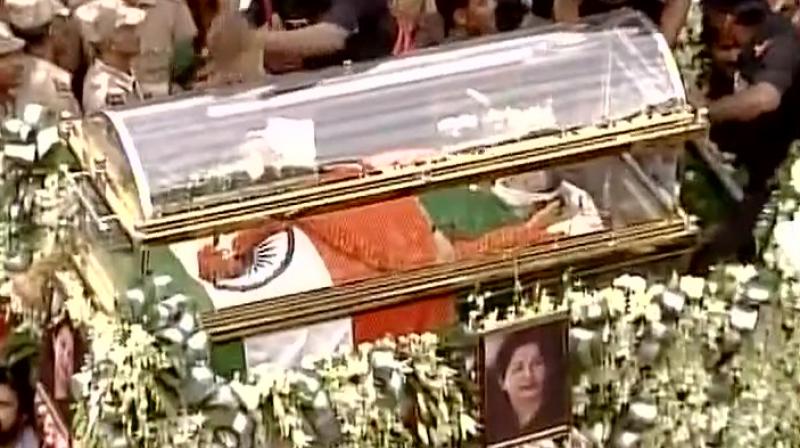Why Jayalalithaa was buried, not cremated

Chennai: Eyebrows were raised at the fact that Ms J.Jayalalithaa, born to Brahmin parents, was buried rather than cremated. Cremation is more a custom with the Brahmin community although there are exceptions as in those taking the austerity vow like sanyasis being buried rather than burnt at the pyre.
While political circles were agog with whispers about the CM’s burial being against traditions and if the ruling party was trying to cash in on burial as a way of keeping the mortal remains in a memorial to perpetuate the image of an iconic Chief Minister, facts suggest it was a party decision that was also backed up a religious traditions with the ceremony itself marked by Brahmin as well as Thevar rituals..
Jaya’s AIADMK, now missing its most charismatic leader in the class of founder MGR, wished to preserve her body as a symbol of her magnetic properties inside the MGR memorial in order to ensure that the crowds of party loyalists would continue to stream in to pay respects and the AIADMK hold on the rural masses would stay intact. Also, to facilitate this, separate environmental and CRZ clearances were not required, nor would they have to seek permission to hold a cremation on Marina Beach. In that sense, this was a practical party decision.
Crowds of loyalists still pour into the MGR memorial and many even place their ear on the mausoleum to check if his watch is still ticking. In such personality-driven Dravidian politics that depended on the leader’s charisma, the AIADMK may have concluded that Jaya’s body in MGR’s memorial would create the dual magic that might otherwise go missing after her demise.
It was for religious reasons that Deepak Jayaraj, a nephew of Jayalalithaa, was made part of the last rites. Also, a particular religious figure was said to have prepared the body for its last journey in Poes Garden in the small hours of Monday in the strictest of Brahmin orthodoxy in following funereal rites and wrapping it in a green sari, etc. It is believed it was on the advice given by a prominent religious head of Srirangam, the town to which Jaya traced family roots, that the Vedic rites were made an integral part of the rituals.
It is believed that the priest’s advice in order that the soul (atma) of Ms Jaya may attain shanthi (peace), her next of kin had to perform the rites too. This is why Deepak, one of the few relatives of Jaya who was allowed to be part of the group tending to the ailing CM in Apollo Hospitals, was asked to be present till the very end when Sasikala and he performed the final rites before the body was lowered in the military tradition of a state funeral with a formal gun salute.
It is also learnt that the burial, and not cremation, had nothing to do with a Dravidian or rationalist tradition as the rites were performed by believers and temple customs were followed with a priest, R. Varadarajan (53), following the tradition of Deiveeham (divinity) conducting the rituals in ensuring that practices like dropping milk on the body as the Thevars do were followed, as also the use of sandalwood logs generally used in pyres.
The combination of rituals may have been aimed to please the Gods, but it certainly put paid to theories about rationalist influence in the glorious last journey of a demigod of Tamil Nadu politics, who was a firm believer.

